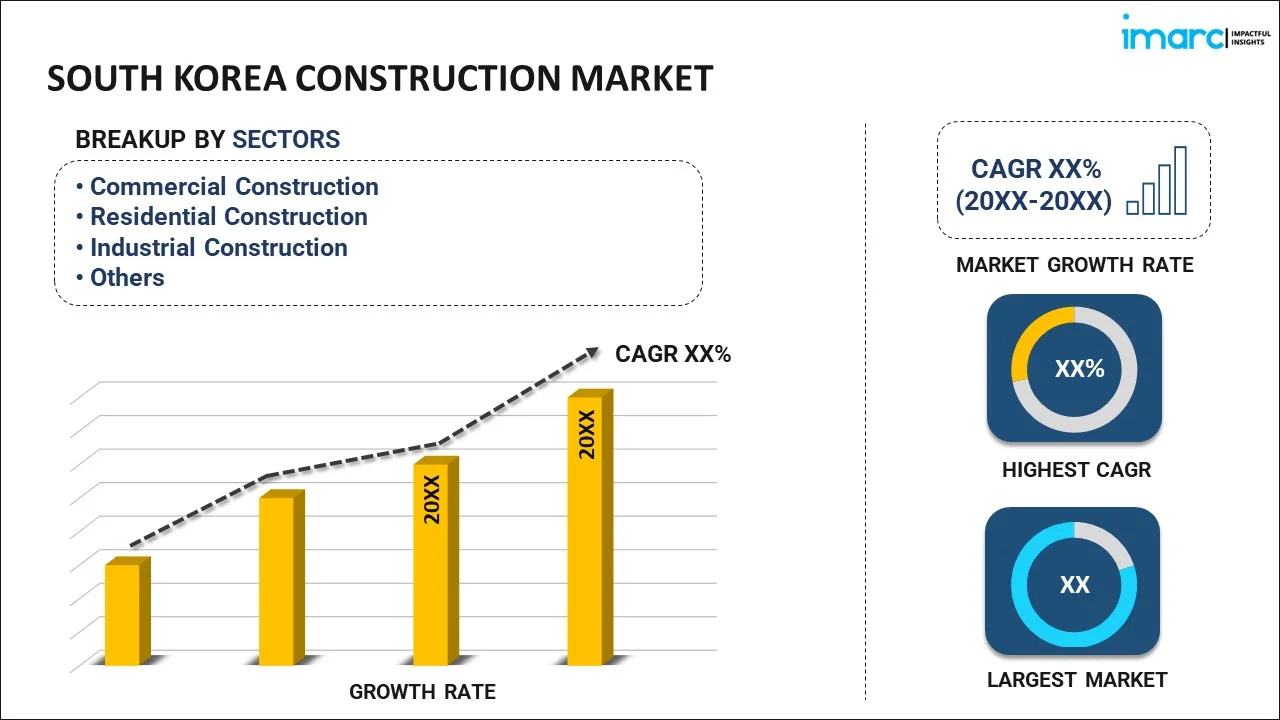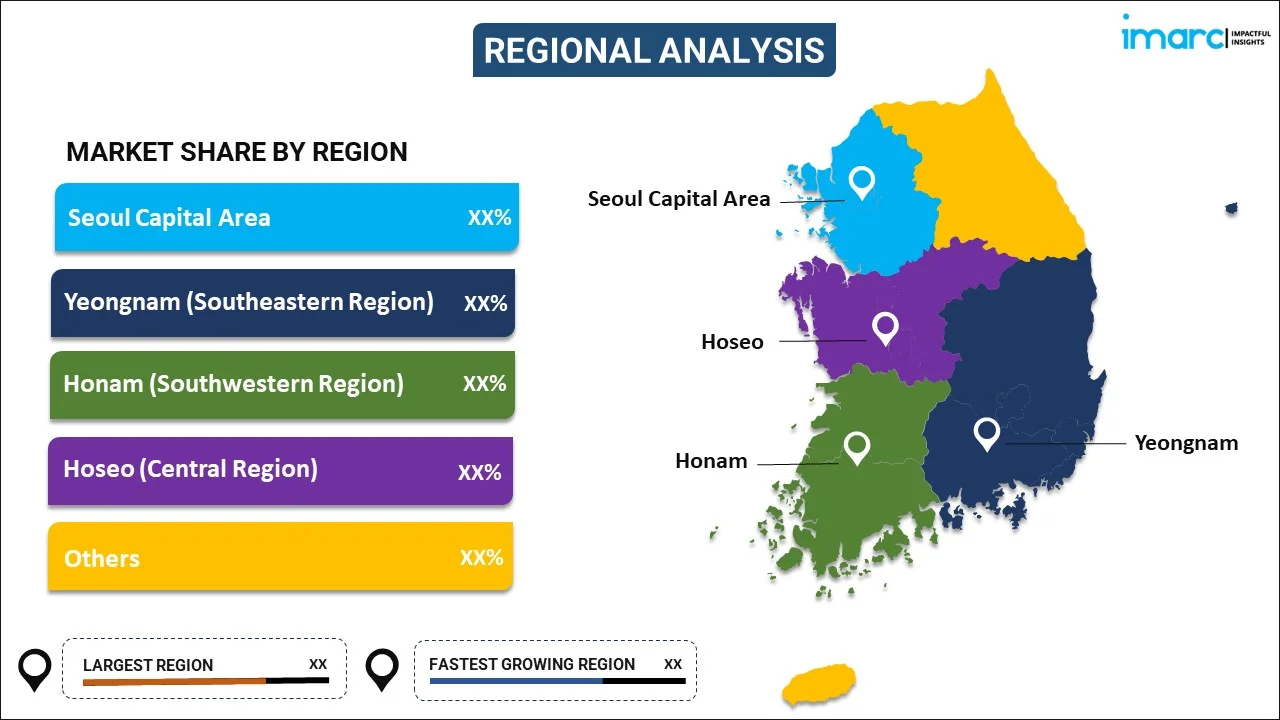
South Korea Construction Market Report by Sector (Commercial Construction, Residential Construction, Industrial Construction, Infrastructure (Transportation) Construction, Energy and Utilities Construction), and Region 2025-2033
Market Overview:
South Korea construction market size reached USD 260.0 Billion in 2024. Looking forward, IMARC Group expects the market to reach USD 470.0 Billion by 2033, exhibiting a growth rate (CAGR) of 6.2% during 2025-2033. The favorable government initiatives, rapid urbanization and infrastructural development, significant technological advancements, rising environmental concerns and regulations, increasing foreign investment, easy access to financial support, and rising political stability regulatory compliance represent some of the key factors driving the market.
|
Report Attribute
|
Key Statistics
|
|---|---|
|
Base Year
|
2024
|
|
Forecast Years
|
2025-2033
|
|
Historical Years
|
2019-2024
|
|
Market Size in 2024
|
USD 260.0 Billion |
|
Market Forecast in 2033
|
USD 470.0 Billion |
| Market Growth Rate 2025-2033 | 6.2% |
Construction is the process of creating physical structures, such as buildings, bridges, roads, and infrastructure, through a systematic sequence of activities and tasks. It encompasses various phases, from initial planning and design to the actual building or assembly of structures. Construction projects typically involve a range of professionals, including architects, engineers, project managers, contractors, and skilled laborers, who collaborate to bring a vision to life. The construction industry plays a pivotal role in shaping the urban landscapes and providing essential facilities for society. It spans residential, commercial, industrial, and civil engineering projects, each with its unique requirements and challenges. Modern construction practices emphasize not only functionality and aesthetics but also sustainability and safety.
South Korea Construction Market Trends:
Rapid urbanization has led to a surge in the demand for residential and commercial real estate. Cities across the country are expanding, creating opportunities for construction companies to build housing complexes, office spaces, and commercial centers to accommodate the growing population. Additionally, the commitment of the country to enhance its infrastructure, including roads, bridges, airports, and ports, is a significant driver. The strategic location of the nation as a gateway to Asia has prompted investments in logistics and transportation infrastructure, making it a regional hub for trade and commerce. Other than this, the South Korean construction companies have expanded their presence internationally, participating in large-scale projects worldwide. This global outreach has increased revenue streams and exposure to diverse markets. Besides this, environmental concerns and regulations have led to a growing emphasis on green and sustainable construction practices. South Korea has witnessed a surge in eco-friendly building designs and materials. In line with this, the country attracts foreign investors interested in real estate development, further stimulating construction activities. Furthermore, access to funding and financial support from banks and institutions has facilitated the execution of large-scale construction projects. Apart from these factors, an aging population has led to increased investment in healthcare facilities and retirement communities, creating opportunities for construction companies specializing in these sectors. Moreover, the political stability and commitment to business-friendly policies have encouraged long-term investments in the construction industry.
South Korea Construction Market Segmentation:
IMARC Group provides an analysis of the key trends in each segment of the market, along with forecasts at the country level for 2025-2033. Our report has categorized the market based on sector.
Sector Insights:

- Commercial Construction
- Residential Construction
- Industrial Construction
- Infrastructure (Transportation) Construction
- Energy and Utilities Construction
The report has provided a detailed breakup and analysis of the market based on the sector. This includes commercial construction, residential construction, industrial construction, infrastructure (transportation) construction, and energy and utilities construction.
Regional Insights:

- Seoul Capital Area
- Yeongnam (Southeastern Region)
- Honam (Southwestern Region)
- Hoseo (Central Region)
- Others
The report has also provided a comprehensive analysis of all the major regional markets, which include Seoul Capital Area, Yeongnam (Southeastern Region), Honam (Southwestern Region), Hoseo (Central Region), and Others.
Competitive Landscape:
The market research report has also provided a comprehensive analysis of the competitive landscape in the market. Competitive analysis such as market structure, key player positioning, top winning strategies, competitive dashboard, and company evaluation quadrant has been covered in the report. Also, detailed profiles of all major companies have been provided.
South Korea Construction Market Report Coverage:
| Report Features | Details |
|---|---|
| Base Year of the Analysis | 2024 |
| Historical Period | 2019-2024 |
| Forecast Period | 2025-2033 |
| Units | Billion USD |
| Scope of the Report | Exploration of Historical Trends and Market Outlook, Industry Catalysts and Challenges, Segment-Wise Historical and Future Market Assessment:
|
| Sectors Covered | Commercial Construction, Residential Construction, Industrial Construction, Infrastructure (Transportation) Construction, Energy and Utilities Construction |
| Regions Covered | Seoul Capital Area, Yeongnam (Southeastern Region), Honam (Southwestern Region), Hoseo (Central Region), Others |
| Customization Scope | 10% Free Customization |
| Post-Sale Analyst Support | 10-12 Weeks |
| Delivery Format | PDF and Excel through Email (We can also provide the editable version of the report in PPT/Word format on special request) |
Key Questions Answered in This Report:
- How has the South Korea construction market performed so far and how will it perform in the coming years?
- What has been the impact of COVID-19 on the South Korea construction market?
- What is the breakup of the South Korea construction market on the basis of sector?
- What are the various stages in the value chain of the South Korea construction market?
- What are the key driving factors and challenges in the South Korea construction?
- What is the structure of the South Korea construction market and who are the key players?
- What is the degree of competition in the South Korea construction market?
Key Benefits for Stakeholders:
- IMARC’s industry report offers a comprehensive quantitative analysis of various market segments, historical and current market trends, market forecasts, and dynamics of the South Korea construction market from 2019-2033.
- The research report provides the latest information on the market drivers, challenges, and opportunities in the South Korea construction market.
- Porter's five forces analysis assist stakeholders in assessing the impact of new entrants, competitive rivalry, supplier power, buyer power, and the threat of substitution. It helps stakeholders to analyze the level of competition within the South Korea construction industry and its attractiveness.
- Competitive landscape allows stakeholders to understand their competitive environment and provides an insight into the current positions of key players in the market.
Need more help?
- Speak to our experienced analysts for insights on the current market scenarios.
- Include additional segments and countries to customize the report as per your requirement.
- Gain an unparalleled competitive advantage in your domain by understanding how to utilize the report and positively impacting your operations and revenue.
- For further assistance, please connect with our analysts.
 Request Customization
Request Customization
 Speak to an Analyst
Speak to an Analyst
 Request Brochure
Request Brochure
 Inquire Before Buying
Inquire Before Buying




.webp)




.webp)












